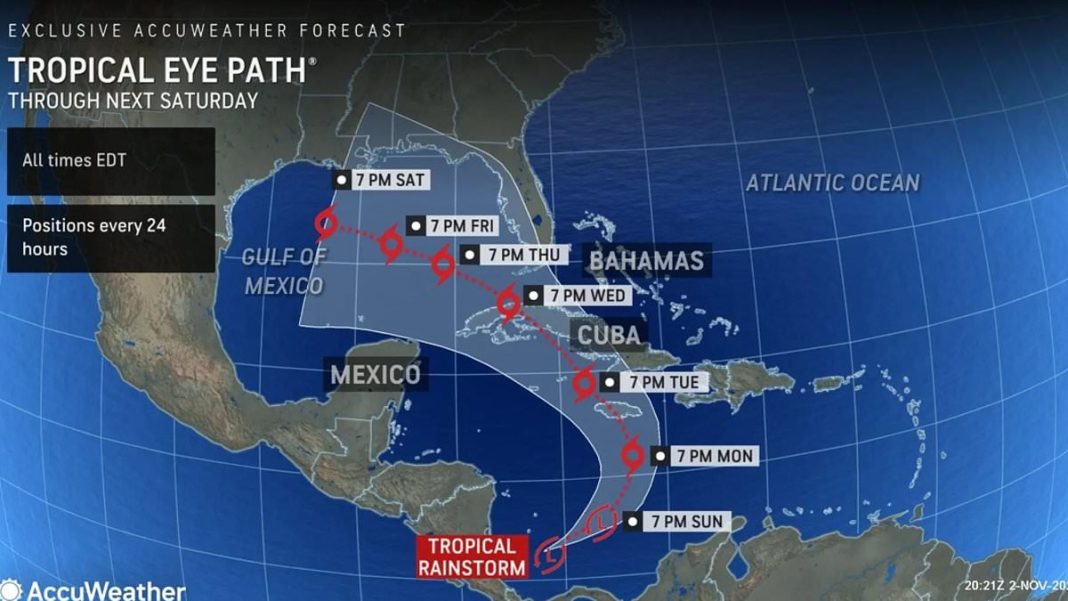Hurricane warning issued as Storm Rafael heads for the US,
Storm Rafael is brewing in the Caribbean – and its effect could impact the US.
The National Hurricane Center (NHC) issued a warning Monday that the storm, currently labeled Tropical Cyclone Eighteen, could hit the Cayman Islands in the next 36 hours.
The high winds could cause Rafael to reach a Category 1 hurricane status in the western Caribbean on Wednesday, but storm trackers said it should weaken to a tropical storm as it moves toward the US Gulf Coast states by the weekend.
As a result, Louisiana, Mississippi andTexas could see heavy rainfall and flooding by Saturday, while the southwestern part of Florida could see minor impacts starting Thursday.
‘Interests in the Florida Keys should closely monitor this system as tropical storm watches could be required for portions of these areas later today,’ NHC shared.
The agency noted that the system is predicted to venture into the Gulf of Mexico later this week but given significant uncertainties in the long-range forecast track and intensity, it is too soon to determine what, if any, impacts could occur.’
November is the final month of hurricane season, but up to three more named storms could form before the end.
AccuWeather lead hurricane expert Alex DaSilva said: ‘There have only been three hurricane landfalls in the US during the month of November since 1900.
‘They all made landfall in Florida. We’ve never seen a tropical storm or hurricane on record make landfall in Texas or Louisiana during the month of November.’
The storm is currently a disturbance in the Caribbean, with a maximum wind speed of 35 miles per hour as it moves about nine miles per hour north.
Once the wind speeds reach 39 miles per hour, it will be upgraded to a tropical storm but will need to reach 74 miles per hour to reach hurricane status.
The NHC’s data predicts that high speed wind from the storm will reach the western tip of Florida Wednesday morning and Louisiana, Mississippi by Thursday evening.
Forecasters aren’t sure whether the storm’s intensity will remain the same as it reaches Florida later this week but said it could bring localized wind damage and flash flooding to some areas.
‘The system is forecast to enter the western Gulf of Mexico later this week, but given significant uncertainties in the long-range forecast track and intensity, it is too soon to determine what, if any, impacts could occur,’ the NHC said.
The agency has placed Cuban under a hurricane watch and Jamaica has a tropical storm warning as of Monday morning.
The storm was located about 220 miles south of Jamaica as of 7am ET on Monday.
‘Rainfall totals between three to six inches with locally up to nine inches are expected. Flooding could occur over portions of Jamaica and Cuba, with mudslides possible,’ the center noted.
It also comes as AccuWeather meteorologists are tracking a second storm in the Atlantic Basin that’s heading east toward Portugal.
The tropical development, which formed on Sunday, is located to the north of the Caribbean and will be monitored through November 8 as it reaches the Bahamas.
However, the high wind shear in the area means the storm will be less likely to develop, but meteorologists warned that it’s close proximity to land ‘warrants close monitoring.’
A wind shear could slow down the storm as it enters the Gulf of Mexico by removing the heat and moisture from the center of the hurricane.
Since 1900, only three hurricanes have made landfall in the US in November – all of which hit Florida – but this is the first time a tropical storm or hurricane will make landfall in Texas or Louisiana.
Lead AccuWeather hurricane expert Alex DaSilva said: ‘We’re in the final month of hurricane season, and we’re expecting one to three named storms to develop this month.’
This marks the 17th storm of this year’s hurricane season which extends through November 30.
‘This has been an extremely impactful hurricane season, and it’s not over yet,’ said DaSilva.
‘AccuWeather experts estimate the total damage and economic loss from landfalling storms in the U.S. this year is approaching $500 billion.’









